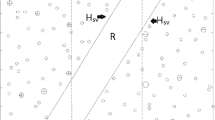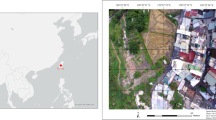Abstract
This paper proposes an automatic framework for land cover classification. In majority of published work by various researchers so far, most of the methods need manually mark the label of land cover types. In the proposed framework, all the information, like land cover types and their features, is defined as prior knowledge achieved from land use maps, topographic data, texture data, vegetation’s growth cycle and field data. The land cover classification is treated as an automatically supervised learning procedure, which can be divided into automatic sample selection and fuzzy supervised classification. Once a series of features were extracted from multi-source datasets, spectral matching method is used to determine the degrees of membership of auto-selected pixels, which indicates the probability of the pixel to be distinguished as a specific land cover type. In order to make full use of this probability, a fuzzy support vector machine (SVM) classification method is used to handle samples with membership degrees. This method is applied to Landsat Thematic Mapper (TM) data of two areas located in Northern China. The automatic classification results are compared with visual interpretation. Experimental results show that the proposed method classifies the remote sensing data with a competitive and stable accuracy, and demonstrate that an objective land cover classification result is achievable by combining several advanced machine learning methods.




Similar content being viewed by others
References
Aitkenhead, M. J., & Aalders, I. H. (2011). Automating land cover mapping of Scotland using expert system and knowledge integration methods. Remote Sensing of Environment, 115(5), 1285–1295.
Belousov, A. I., Verzakov, S. A., & von Frese, J. (2002). A flexible classification approach with optimal generalisation performance: support vector machines. Chemometrics and Intelligent Laboratory Systems, 64(1), 15–25.
Bengio, Y. (2009). Learning deep architectures for AI. Foundations and Trends in Machine Learning, 2(1), 1–127.
Berberoglu, S., Lloyd, C. D., Atkinson, P. M., & Curran, P. J. (2000). The integration of spectral and textural information using neural networks for land cover mapping in the Mediterranean. Computers & Geosciences, 26(4), 385–396.
Blaschke, T. (2010). Object based image analysis for remote sensing. ISPRS Journal of Photogrammetry and Remote Sensing, 65(1), 2–16.
Chang, C. C., & Lin, C. J. (2011). LIBSVM: a library for support vector machines. ACM Transactions on Intelligent Systems and Technology (TIST), 2(3), 27.
Chen, J., Wang, C., & Wang, R. S. (2009). Using stacked generalization to combine SVMs in magnitude and shape feature spaces for classification of hyperspectral data. IEEE Transactions on Geoscience and Remote Sensing, 47(7), 2193–2205.
Fardanesh, M. T., & Ersoy, O. K. (1998). Classification accuracy improvement of neural network classifiers by using unlabeled data. IEEE Transactions on Geoscience and Remote Sensing, 36(3), 1020–1025.
Foody, G. M., & Mathur, A. (2006). The use of small training sets containing mixed pixels for accurate hard image classification: training on mixed spectral responses for classification by a SVM. Remote Sensing of Environment, 103(2), 179–189.
Foody, G. M., Mathur, A., Sanchez-Hernandez, C., & Boyd, D. S. (2006). Training set size requirements for the classification of a specific class. Remote Sensing of Environment, 104(1), 1–14.
Franklin, S. E., & Wulder, M. A. (2002). Remote sensing methods in medium spatial resolution satellite data land cover classification of large areas. Progress in Physical Geography, 26(2), 173–205.
Friedl, M. A., Sulla-Menashe, D., Tan, B., Schneider, A., Ramankutty, N., Sibley, A., & Huang, X. (2010). MODIS collection 5 global land cover: algorithm refinements and characterization of new datasets. Remote Sensing of Environment, 114(1), 168–182.
Hinton, G. E., & Salakhutdinov, R. R. (2006). Reducing the dimensionality of data with neural networks. Science, 313(5786), 504–507.
Homer, C. C., Huang, L., Yang, B. W., & Coan, M. (2004). “Development of a 2001 National Landcover Database for the United States.”. Photogrammetric Engineering and Remote Sensing, 70(7), 829–840.
Horn, B. (1981). Hill shading and the reflectance map. Proceedings of the IEEE, 69(1), 14–47.
Huang, C., Davis, L. S., & Townshend, J. (2002). An assessment of support vector machines for land cover classification. International Journal of Remote Sensing, 23(4), 725–749.
Inglada, J. (2007). Automatic recognition of man-made objects in high resolution optical remote sensing images by SVM classification of geometric image features. ISPRS Journal of Photogrammetry and Remote Sensing, 62(3), 236–248.
Keuchel, J., Naumann, S., Heiler, M., & Siegmund, A. (2003). Automatic land cover analysis for Tenerife by supervised classification using remotely sensed data. Remote Sensing of Environment, 86(4), 530–541.
Li, J., & Narayanan, R. M. (2004). Integrated spectral and spatial information mining in remote sensing imagery. IEEE Transactions On Geoscience and Remote Sensing, 42(3), 673–685.
Lin, C., & Wang, S. (2002). Fuzzy support vector machines. IEEE Transactions on Neural Networks, 13(2), 464–471.
Liu, Q. S., & Metaxas, D. N. (2009). Unifying subspace and distance metric learning with Bhattacharyya coefficient for image classification. Emerging Trends in Visual Computing, 5416, 254–267.
Loveland, T. R., Reed, B. C., Brown, J. F., Ohlen, D. O., Zhu, Z., Yang, L., & Merchant, J. W. (2000). Development of a global land cover characteristics database and IGBP DISCover from 1 km AVHRR data. International Journal of Remote Sensing, 21(6–7), 1303–1330.
Lu, D., & Weng, Q. (2007). A survey of image classification methods and techniques for improving classification performance. International Journal of Remote Sensing, 28(5), 823–870.
Lunetta, R. S., Knight, J. F., Ediriwickrema, J., Lyon, J. G., & Worthy, L. D. (2006). Land-cover change detection using multi-temporal MODIS NDVI data. Remote Sensing of Environment, 105(2), 142–154.
Maulik, U., & Chakraborty, D. (2011). A self-trained ensemble with semisupervised SVM: an application to pixel classification of remote sensing imagery. Pattern Recognition, 44(3), 615–623.
Melgani, F., & Bruzzone, L. (2004). Classification of hyperspectral remote sensing images with support vector machines. IEEE Transactions on Geoscience and Remote Sensing, 42(8), 1778–1790.
Miller, J., & Franklin, J. (2002). Modeling the distribution of four vegetation alliances using generalized linear models and classification trees with spatial dependence. Ecological Modelling, 157(2), 227–247.
Mountrakis, G., Im, J., & Ogole, C. (2011). Support vector machines in remote sensing: a review. ISPRS Journal of Photogrammetry and Remote Sensing, 66(3), 247–259.
Raun, W. R., Solie, J. B., Martin, K. L., Freeman, K. W., Stone, M. L., Johnson, G. V., & Mullen, R. W. (2005). Growth stage, development, and spatial variability in corn evaluated using optical sensor readings. Journal of Plant Nutrition, 28(1), 173–182.
Stehman, S. V. S. S. (2009). Sampling designs for accuracy assessment of land cover. International Journal of Remote Sensing, 30(20), 5243–5272.
Trias-Sanz, R., Stamon, G., & Louchet, J. (2008). Using colour, texture, and hierarchial segmentation for high-resolution remote sensing. ISPRS Journal of Photogrammetry and Remote Sensing, 63(2), 156–168.
Tsai, F., & Philpot, W. D. (2002). A derivative-aided hyperspectral image analysis system for land-cover classification. IEEE Transactions on Geoscience and Remote Sensing, 40(2), 416–425.
Tuia, D., Ratle, F., Pacifici, F., Kanevski, M. F., & Emery, W. J. (2009). Active learning methods for remote sensing image classification. IEEE Transactions on Geoscience and Remote Sensing, 47(7), 2218–2232.
van der Meer, F. (2006). The effectiveness of spectral similarity measures for the analysis of hyperspectral imagery. International Journal of Applied Earth Observation and Geoinformation, 8(1), 3–17.
Vapnik, V., & Vashist, A. (2009). A new learning paradigm: Learning using privileged information. Neural Networks, 22(5–6), 544–557.
Wardlow, B. D., & Egbert, S. L. (2003). A state-level comparative 7analysis of the GAP and NLCD land-cover data sets. Photogrammetric Engineering and Remote Sensing, 69(12), 1387–1397.
Xing, E.P., Ng, A.Y., Jordan, M.I., & Russell, S. (2003). “Distance metric learning with application to clustering with side-information.” Advances in neural information processing systems 521-528.
Zhang, L. P., Huang, X., Huang, B., & Li, P. X. (2006). A pixel shape index coupled with spectral information for classification of high spatial resolution remotely sensed imagery. IEEE Transactions on Geoscience and Remote Sensing, 44(10Part 2), 2950–2961.
Acknowledgments
This paper is supported by the National Natural Science Foundation of China with Grant NO. 41101398, 41271367 and 61340058; Key Projects in the National Science & Technology Pillar Program with Grant NO. 2011BAH06B02.
Author information
Authors and Affiliations
Corresponding author
About this article
Cite this article
Xia, L., Luo, J., Wang, W. et al. An Automated Approach for Land Cover Classification Based on a Fuzzy Supervised Learning Framework. J Indian Soc Remote Sens 42, 505–515 (2014). https://doi.org/10.1007/s12524-013-0352-6
Received:
Accepted:
Published:
Issue Date:
DOI: https://doi.org/10.1007/s12524-013-0352-6




